Here comes the BOOM!
Common Nighthawks finding love in a pine savanna
By Alexa Mainella
PhD student, Dept. of Environmental Engineering Sciences
Have you ever had a professor drop you off in the middle of nowhere and say, more or less, “Get out there and learn something! I’ll be back for you later”? No? Well, it’s happened to me…many times. The following story relays my most recent experience with that at the University of Florida’s Ordway-Swisher Biological Station (OSBS) in Hawthorne, Florida. It was the fourth day of a week-long intensive summer class I signed up for called “Ancient Bird Language for Modern Naturalists,” aimed to teach students how to sharpen their observational skills regarding animal behavior, mostly birds. So there I was, dropped off on a road in OSBS with notebook and chair in hand, ready to conduct my first solo “bird sit,” roughly defined as “sitting, observing, and recording” any bird behavior I see and hear.
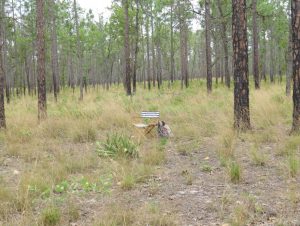
My “bird sit” story: As the sound of the van disappeared, I closed my eyes and listened. Peent…peent…peent. “That’s it!” I remember thinking as I walked among the longleaf pine and wiregrass clumps towards the curious sound. The iconic peent calls of the Common Nighthawk were getting closer, so I sat under a longleaf pine and waited. I could hear thunder far off and I started to worry I wouldn’t get my chance to witness the incredible display of male Common Nighthawks defending their territories (territorial aggression) and attracting females. Common Nighthawks are crepuscular birds (active at dusk and dawn) that can be seen swiftly maneuvering to catch flying insects on the wing. Also termed nightjars, frogmouths, bullbats, and even goatsuckers (an ancient folk tale started by farmers who thought these birds were sucking milk from their goats), Common Nighthawks are incredibly cryptic and easily blend in with the tree branches they tend to perch on when they’re not foraging. While solitary most of the year, male nighthawks meet in the spring on their local lek (i.e. mating grounds) to set up territories and impress the local females.
Bachman’s Sparrows continued singing as I walked slowly towards the nighthawk lek, trying not to set off any bird alarms; they seemed unperturbed by my small zone of disturbance. The wind picked up as the storm got closer, and the entire savanna went silent. The Bachman’s Sparrows stopped singing. I couldn’t hear the peent calls anymore. I could see a couple of Blue Jays high in the tree canopy, possibly searching for other birds’ nests and their unguarded contents. But after 30 minutes of waiting, something incredible happened: the wind died down around 4:00pm, and a lone male Summer Tanager began chirping from the dead branches of an oak tree about 100 meters from me. And then another Summer Tanager behind me started chirping in response to the male. They were the initial notes of a stunning crescendo of sound! Great-crested Flycatchers began calling, followed by the Red-headed Woodpeckers, Bachman’s Sparrows, and Pine Warblers, each species adding depth and variety to the song, similar to an orchestra approaching the climax of a piece of music as baseline bird behavior was returning to the savanna. The bird-song intensified until it finally reached its zenith: the Common Nighthawks had arrived.
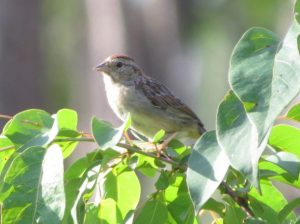
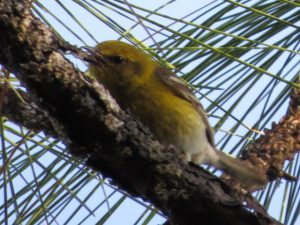
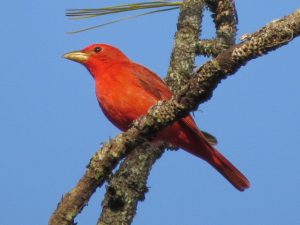
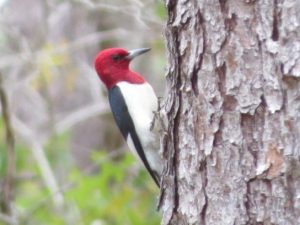
I could see at least ten nighthawks swooping and calling just above the trees, each one flashing white patches on wings almost too long for their small, cigar-shaped bodies. Finally, the moment I had been waiting for: one male hovered in the air for a couple seconds, and then went into a steep dive, only pulling up about 20 feet from the ground and creating the loud BOOM noise that sounds like a weird frog croaking or a small motorcycle zooming past1,2. This BOOM is achieved by air passing through the primary flight feathers on the male’s wings at the bottom of their dive. The diving and booming are used by males to attract females and, hopefully, mate with them. I did not witness territorial aggression between males during my “bird sit,” but the night after, the other students and I came back to the exact spot and saw one male chase another from his territory; they swooped dangerously close to our heads!
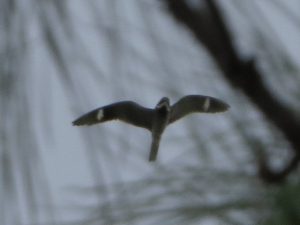
I could hear more and more males booming around me in their territories, working hard to find “love” in the pine savanna and pass on their genes. One male even landed on a branch above my head and I could see him slightly swaying back and forth. This behavior occurs when females are close by, but I didn’t see other nighthawks in the trees. I was surprised at how close the male got to me; perhaps my zone of disturbance was small or he didn’t see me as a threat. Or maybe he was so focused on his display that he didn’t care I was watching; but if the male was successful in attracting a female, the pair would end up mating and she would eventually lay 1-3 cryptically-colored eggs directly on the ground in an open spot on top of sand and some leaf litter. And from those eggs, baby nighthawks would emerge as fluffy, cotton ball versions of their parents, waiting inconspicuously for their mom to bring food. Many bird species produce hatchlings that are naked and helpless (i.e. altricial young), such as the Northern Cardinals and Northern Mockingbirds that you see in your backyard, while other species, like gulls and terns, have down-covered young that are able to see and run around (i.e. precocial young) after hatching. Common Nighthawks are unusual in that their young are semi-precocial, meaning they are born covered in fluffy down with their eyes open, but they stay in the nest and are fed by their parents. Thirty days later, the chicks will be proficient flyers and ready to stop mooching off mom and dad.
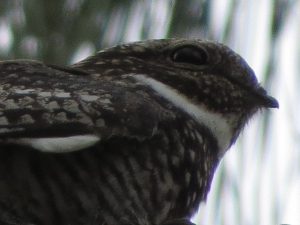
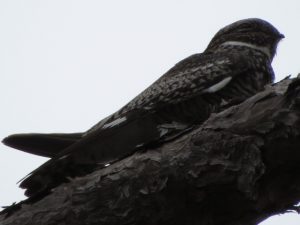

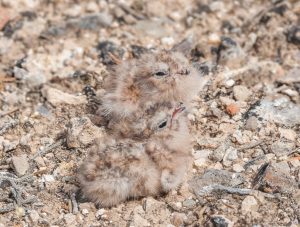
The end of my experience…the beginning of yours! My professor did eventually pick me up on the road, but instead of looking worried as I probably did when she dropped me off, I was smiling ear-to-ear. I had successfully observed bird language in a longleaf pine savanna, including Common Nighthawks conducting their aerial display. Year after year from late April to July, these aerial acrobats flock to the nearest lek in the United States (except Alaska and Hawaii) and western Mexico, and dive expertly among the trees, chase after intruders on their territory, and BOOM for females. But no matter if you’re in a town, prairie, woodland, beach, or a longleaf pine savanna, remember to look up at dusk or dawn and listen for the peent of calling nighthawks. If you’re lucky enough to stumble on a lek, a male just might dive above your head and scare you with his loud BOOM noise. Although a very common species (hence the name), these wonderful birds definitely deserve their time in the spotlight…most likely around street lamps as they dive for insects.
Photo credits Figures 1-5: Alexa Mainella © 2017
Resources for more information:
- Common Nighthawk flight calls and male booming: https://www.youtube.com/watch?v=0aHlV7syK1Q&feature=youtu.be&t=49
- Recording of Common Nighthawk by Pete Monte from the Sieving lab at the University of Florida: https://search.macaulaylibrary.org/catalog?q=Peter+Monte&searchField=user&taxonCode=®ionCode=&userId=USER437852
- Common Nighthawk nest: http://www.nemesisbird.com/news/common-nighthawk-nest/
- Common Nighthawk chicks and various other photos: http://neovistabirding.blogspot.com/2015/07/a-new-generation-of-common-nighthawks.html
- Additional information on Common Nighthawks: https://www.allaboutbirds.org/guide/Common_Nighthawk/lifehistory
Further Reading: Ancient Bird Language and the Students who Learn it
 0
0
